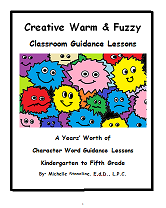Sand tray student # 7: Multicultural Project for Sand Tray Therapy Class
by Student # 7
(Stockbridge, Ga)
For my sand tray therapy multicultural project, I chose to research the Gullah/Geechee culture. My family is from Charleston, South Carolina, so I decided to do more research to learn more about my ancestral background. In this research paper, I discuss important values found in this culture, which has been preserved for hundreds of years. Strong values are placed on food and family, spirituality, utilizing natural materials to make products, and storytelling to teach lessons. The miniatures I have chosen symbolizes important themes found in this culture and include trees and flowers, animals, a cross, and a medicine bottle. More detailed explanations are provided in the body of the paper below.
Introduction to the Gullah/Geechee Culture
The Gullah/Geechee culture is one that is very unique in that it is a group of people who have been able to preserve their African roots for hundreds of years. Although the culture is said to be dying out, it still has a major influence in the lives of many African Americans all over the United States whether they realize it or not. The name “Geechee” may have derived from the Ogeechee River and is the term used in Georgia while “Gullah” is the term used in the Carolinas. Enslaved people from this culture were brought to Charleston, South Carolina from West Africa as early as the 1700s to work as slaves on plantations growing rice, cotton, and indigo. Most research supports claims that the “Gullah” originate from West African ethnic groups such as Angola, Sierra Leone, Liberia, etc…
Gullah-Geechee people are descendants of enslaved Africans from various ethnic groups of west and central Africa who were forced to work on the plantations of coastal South Carolina, Georgia, North Carolina, and Florida. The Gullah/Geechee people are survivors - unique groups of African-Americans who lived near the coast and on barrier islands that were separated from the mainland by creeks, rivers, and marshes. Native Americans were also members of these communities, and, as a result, they also had some cultural influences on the Gullah culture as well. Because of their geographic protection from outsiders and strong sense of family and community, Gullah/Geechee people maintained a separate Creole language and developed distinct cultural patterns which was a combination of the African cultural tradition as well as Native American beliefs; the Gullah culture is credited for being able to preserve more of their African culture than any other group of African-Americans in other parts of the United States. Even though the culture was preserved because of isolated living conditions on the sea island regions, its influence has reached far beyond ever imagined to all parts of the United States. Because this is one of the few cultures in America that has been able to preserve its African roots, there are symbols in the culture that are not only easy to recognize but also serve a distinct purpose in the culture.
Food as a Symbol in Gullah Culture
Food is very important in the Geechee culture; it is a symbol of closeness to African roots as most of the dishes closely resemble popular African dishes. In addition, food in the Gullah culture also represents or symbolizes closeness to family and sharing love and appreciation for one another. A lot of the dishes original to the Gullah/Geechee people such as “hoppin john,” “okra soup,” and “red rice” are meals that are eaten quite frequently and are very common among dishes in the south. “Red rice” bears great resemblance to “jollof rice” which is a West African dish. These dishes are a representation of the importance of preserving one’s culture even through very trying times. This symbol demonstrates the strength and closeness of members of this cultural group and their dedication to knowingly or unknowingly pass down traditions through food from one generation to the next. Additionally, food is not just about providing nourishment for the body; it is also a time to celebrate and rejoice in the fact that food provides healing. The miniature that I have picked to symbolize the healing power of food in this culture is a medicine bottle. When we take medicine, it makes us feel better. In this culture, cooking, eating, and sharing food is a way to provide healing. “Good food is medicine for the soul” (Jarrett, C, 2000, pg. 24).
Baskets, Quilts, and other Hand-Made Goods
Anyone who has ever made a quilt, basket, or any other material good knows that it takes time to complete these objects. Hand-made baskets, quilts, etc…are another very distinct feature in the Gullah culture and symbolizes patience as well as understanding that God gives people gifts to be able to make such objects. “Gullah/Geechee people insist that energy flows from the Almighty through the hands of each human” (Jarrett, C, 2000, pg. 25). The Gullah people are famous for their baskets, quilts, fishing nets, casting nets, etc… In this culture, it is also important to live in harmony and peace with the Earth; these materials represent that harmony because they are all made from materials that are indigenous to the earth. “The crafting of sweet grass baskets form a visible link to the African heritage of the Gullah people” (Jarrett, C, 2000, pg. 24). These baskets were vital in the production of rice, cotton and indigo. The miniatures that are appropriate metaphors to symbolize not only the importance of nature but also the ability to utilize the natural gifts that God has made available for our use are a tree and a flower. Trees and flowers represent the earth and the people of this culture values and respects the earth; the products that they produce are a display of their love for the earth and taking what God provided us and turning it into something that is useful in everyday life.
Spirituality and the Grave
The Gullah culture has its foundation on religious beliefs. This culture believes that God is first in everything. Even though this culture is grounded in Christian beliefs, there are also legends and folklore that also serve as a driving force for their religious foundations. For example, when a loved one dies, it is believed that even though the person’s soul goes back to God, their spirit is still here on the earth. In order to demonstrate this belief, graves are elaborately decorated or “dressed” with the possessions of the deceased. In Gullah culture, it is believed that the dead walk among us and people’s ancestors are able to walk, guide, and lead their family through spiritual means. Therefore, the grave is not viewed as a final goodbye; it symbolizes a person being able to exist in two realms; here on earth and in heaven with Jesus. The miniature I have chosen to represent spirituality in the Gullah culture is a cross; it is a symbol of the importance of their religious beliefs and faith in God.
Storytelling and Oral Tradition
Storytelling is a major piece of the Gullah culture. Through storytelling, many lessons have been passed down from generation to generation. Passing down stories through oral tradition is a way to provide entertainment as well as teach important life lessons that can sustain people regardless of race or culture. Gullah folklore often showcase animals as the main characters and usually involve one character out-smarting another which is very similar to African tales. One of the most popular characters used in Gullah folklore is the cunning trickster named Brer Rabbit who often out-smarts his adversaries. Therefore, the character Brer Rabbit and other characters used in storytelling symbolizes the culture’s appreciation of art, entertainment, and being able to teach life lessons to others. Many times, we may not look at animals and think that they can be used in creative ways to teach a lesson; this culture is unique in that it has done just that. I have chosen a group of animals because in this culture, animals have an important place in the history of oral traditions and are used to teach valuable lessons in the form of storytelling.
References
http://www.fyicomminc.com/gaianews/speech15.htm
http://www.georgiaencyclopedia.org/nge/Article.jsp?id=h-1063
http://www.knowitall.org/gullahnet/gullah/traditions.html
Jarrett, C. Introducing Folknography: A study of the gullah culture.
Disclaimer: This website and its content is intended for trained licensed mental health professionals and school certified mental health professionals to use for their clients / students at their own discretion.
*If you ignore the disclaimer above are using these techniques on yourself and you feel any discomfort or upset it is highly suggested that you seek out a licensed mental health professional immediately.
"Beyond Art Therapy" is the concept from Dr. Stangline that combines all creative fields in therapy. It is not the traditional "art therapy" but goes beyond to include sand tray therapy, play therapy, mindfulness, meditation, color therapy, cognitive behavioral therapy, and a vast majority of other therapies.
For any other type of mental health emergency call your local 911 / Police Number immediately.
Dr. Stangline does not offer advice / suggestions to anyone who is not a professional mental health provider, or a student who is studying this field and has questions about mental health programs of study.
See our Exciting Selection of eBooks:
Award Winning:
Creative Counseling 101 eBook
Our Best Seller!
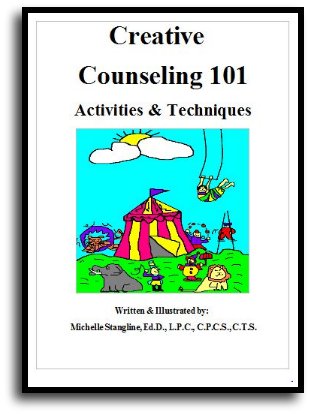
Step By Step Therapy:
Learn how to be a more Creative Therapist with the Book that started it all!
- Graduate School Counseling book used by hundreds of graduate counseling students!
- Includes full color reproducible worksheets with most activities.
- Winner of the Counselor Writer of the Year Award, 2011, Georgia Regional Award
Download Your Copy Today Only $39.95:
See Creative Counseling 101 eBook Information Here:
Get the Set
of all four
eBooks for only $98.95:
An incredible collection of how to do therapy eBooks!
A $159.80 Value,
You Save Over $60!
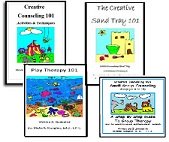
Get your complete set of the Creative Counseling 101.com eBooks by Dr. Michelle Stangline for only $98.95, that's less than $25.00 per eBook (Regular Price is $39.95 for each eBook.).
Your complete set includes:
- Creative Counseling 101
- Creative Group Counseling 101
- Creative Play Therapy 101
- Creative Sand Tray 101
For more information click the link below:
See Complete Set of eBooks For Sale Here:
New!!! "Beyond Art Therapy" 101 eBook
Over 300 pages of Beyond Art Therapy activities and techniques. Learn what I teach graduate counseling students!
See the link below for more information.
Only $39.95
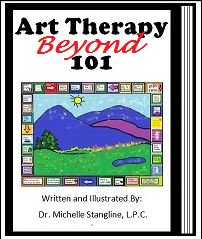
See More Invividual eBooks For Sale:
Sand Tray Therapy 101 eBook:
Learn how to do Sand Tray Therapy or enhance your skills.
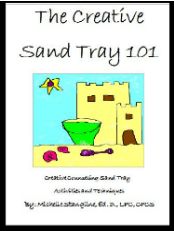
Play Therapy 101 eBook
Learn how to do play therapy or enhance your skills.
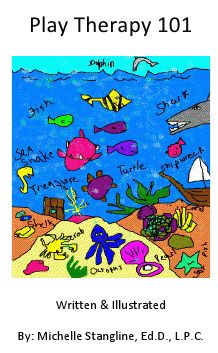
Small Group Counseling eBook For Sale:
Learn how to do creative group therapy and enhance your skills.
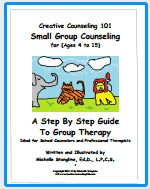
School Counselor Guidance Lesson & Social Stories eBook for sale:
Get a year's worth of school counselor guidance lessons with "Creative Warm & Fuzzy Classroom Guidance Lessons eBook". Introduce your students to the "Warm & Fuzzy Way". Click the link below for more information:
Warm & Fuzzy School Counselor Guidance Lessons eBook
